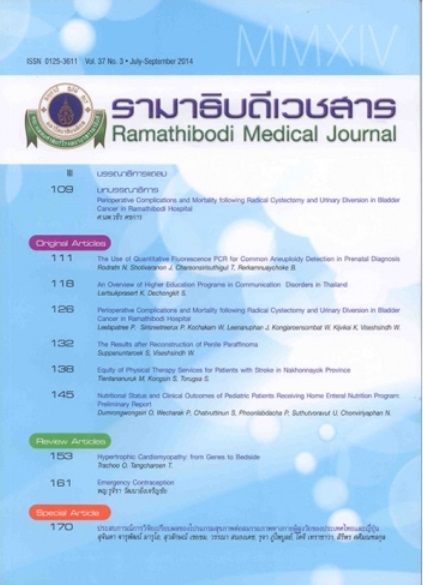Nutritional Status and Clinical Outcomes of Pediatric Patients Receiving Home Enteral Nutrition Program: Preliminary Report
Keywords:
Home enteral nutrition, Nutritional ststus, Feeding complicationAbstract
Background: An appropriate nutritional management is necessary for patients who need enteral nutrition via tube feeding with regard to nutritional status and complications.
Objective: To evaluate the nutritional status and clinical outcomes of pediatric patients receiving the home enteral nutrition program of the Center for Home Parenteral and Enteral Nutrition (HOPE)
Methods: Data from medical records and the HOPE nutrition record forms was collected and analyzed in this preliminary study. The median age of patients when starting to receive this home enteral nutrition program was 2 years old (range from 0.75 to 17 years old). The proportion of patients with underweight, stunting and wasting at entry and after being under care of Center for HOPE were 53.4% vs 33.3%, 63.3% vs 57.1%, and 33.3% vs 15%, respectively. Feeding-related complications were found in 25% of patients (11/43). Eighteen percent of patients was able to wean off enteral nutrition via tube feeding.
Conclusions: The results of this study suggest that the home enteral nutrition program of the Center for HOPE helps patients to improve their nutritional status and one-fifth of patients can wean off enteral nutrition.
References
Vohr BR, Stephens BE, McDonald SA, et al. Cerebral palsy and growth failure at 6 to 7 years. Pediatrics. 2013;132(4):e905- e914. doi:10.1542/peds.2012-3915.
Andrew MJ, Sullivan PB. Growth in cerebral palsy. Nutr Clin Pract. 2010;25(4):357-361. doi:10.1177/0884533610374061.
Lochs H, Allison SP, Meier R, et al. Introductory to the ESPEN Guidelines on Enteral Nutrition: Terminology, definitions and general topics. Clin Nutr. 2006;25(2):180-186.
Braegger C, Decsi T, Dias JA, et al. Practical approach to paediatric enteral nutrition: a comment by the ESPGHAN committee on nutrition. J Pediatr Gastroenterol Nutr. 2010;51(1):110-122. doi:10.1097/MPG.0b013e3181d336d2.
Diamanti A, Di Ciommo VM, Tentolini A, et al. Home enteral nutrition in children: a 14-year multicenter survey. Eur J Clin Nutr. 2013;67(1):53-57. doi:10.1038/ejcn.2012.184.
Pedrón-Giner C, Calderón C, Martínez-Zazo A, Cañedo Villaroya E, Malillos González P, Sesmero-Lillo MÁ. Home enteral nutrition in children: a 10 year experience with 304 pediatric patients. Nutr Hosp. 2012;27(5):1444-1450. doi:10.3305/nh.2012.27.5.5898.
Daveluy W, Guimber D, Mention K, et al. Home enteral nutrition in children: an 11-year experience with 416 patients. Clin Nutr. 2005;24(1):48-54.
Pedrón-Giner C1, Navas-López VM, Martínez-Zazo AB, et al. Analysis of the Spanish national registry for pediatric home enteral nutrition (NEPAD): implementation rates and observed trends during the past 8 years. Eur J Clin Nutr. 2013;67(4):318-323. doi:10.1038/ejcn.2013.8.
Salomon Zaban AL, Garbi Novaes MR. Home enteral nutrition in children: a one-year experience with 184 patients in Distrito Federal, Brazil. Exp Biol Med (Maywood). 2010;235(5):584-589. doi:10.1258/ebm.2009.009213.
Department of Health, Ministry of Public Health. Thai Weight, Height, and Nutrition Standard References Aged 1-19 years. 1999.
Andrew MJ, Parr JR, Sullivan PB. Feeding difficulties in children with cerebral palsy. Arch Dis Child Educ Pract Ed. 2012;97(6):222-229. doi:10.1136/archdischild-2011-300914.
Reilly S, Skuse D, Poblete X. Prevalence of feeding problems and oral motor dysfunction in children with cerebral palsy: a community survey. J Pediatr. 1996;129(6):877-882.
Fung EB, Samson-Fang L, Stallings VA, et al. Feeding dysfunction is associated with poor growth and health status in children with cerebral palsy. J Am Diet Assoc. 2002;102(3):361-373.
Wilken M, Cremer V, Berry J, Bartmann P. Rapid home-based weaning of small children with feeding tube dependency: positive effects on feeding behaviour without deceleration of growth. Arch Dis Child. 2013;98(11):856-861. doi:10.1136/archdischild-2012-303558.
Klek S, Hermanowicz A, Dziwiszek G, et al. Home enteral nutrition reduces complications, length of stay, and health care costs: results from a multicenter study. Am J Clin Nutr. 2014;100(2):609-615. doi:10.3945/ajcn.113.082842.
Kang A, Zamora SA, Scott RB, Parsons HG. Catch-up growth in children treated with home enteral nutrition. Pediatrics. 1998;102(4 Pt 1):951-955.
Downloads
Published
How to Cite
Issue
Section
License
Copyright (c) 2014 By the authors. Licensee RMJ, Faculty of Medicine Ramathibodi Hospital, Mahidol University, Bangkok, Thailand

This work is licensed under a Creative Commons Attribution-NonCommercial-NoDerivatives 4.0 International License.













